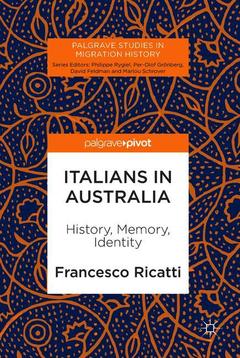Description
Italians in Australia, 1st ed. 2018
History, Memory, Identity
Palgrave Studies in Migration History Series
Author: Ricatti Francesco
Language: English
Keywords
Transnational; Migrant; Post-war; Sugar plantations; Financial crisis; Memory; Community; Class; Race; Gender; Health; Age
Support: Print on demand
Description
/li>Contents
/li>Biography
/li>Comment
/li>
This book provides a concise and innovative history of Italian migration to Australia over the past 150 years. It focuses on crucial aspects of the migratory experience, including work and socio-economic mobility, disorientation and reorientation, gender and sexual identities, racism, sexism, family life, aged care, language, religion, politics, and ethnic media. The history of Italians in Australia is re-framed through key theoretical concepts, including transculturation, transnationalism, decoloniality, and intersectionality. This book challenges common assumptions about the Italian-Australian community, including the idea that migrants are ?stuck? in the past, and the tendency to assess migrants? worth according to their socio-economic success and their alleged contribution to the Nation. It focuses instead on the complex, intense, inventive, dynamic, and resilient strategies developed by migrants within complex transcultural and transnational contexts. In doing so, this book provides a new way of rethinking and remembering the history of Italians in Australia.
1. Mapping complexity: a transcultural approach.- 2. Historical outline.- 3. Work and socio-economic mobility.- 4. Racism and racial ambiguity in a settler colonial context.- 5. Family and generational negotiations.- 6. Transnational ideologies and transcultural practices.- 7. Concluding remarks.
Francesco Ricatti is Cassamarca Senior Lecturer in Italian Studies at Monash University, Australia, and an Adjunct Senior Lecturer in Creative Humanities at the University of the Sunshine Coast, Australia.
These books may interest you

Italians and Food 126.59 €



